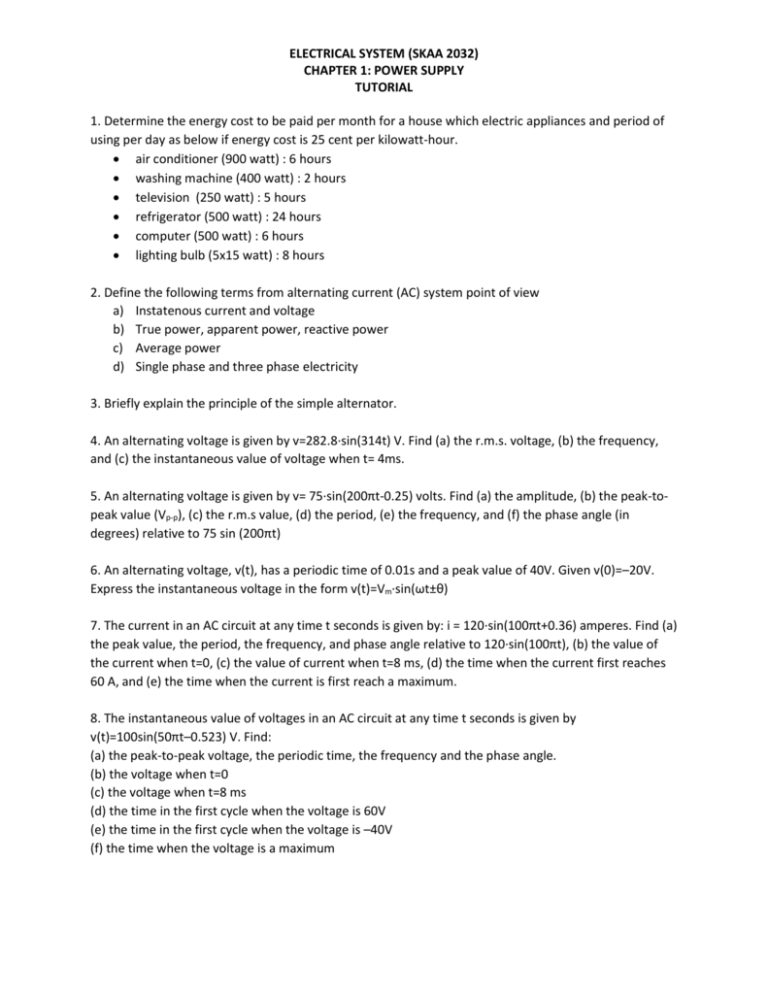tutorial_1 - WordPress.com
advertisement

ELECTRICAL SYSTEM (SKAA 2032) CHAPTER 1: POWER SUPPLY TUTORIAL 1. Determine the energy cost to be paid per month for a house which electric appliances and period of using per day as below if energy cost is 25 cent per kilowatt-hour. air conditioner (900 watt) : 6 hours washing machine (400 watt) : 2 hours television (250 watt) : 5 hours refrigerator (500 watt) : 24 hours computer (500 watt) : 6 hours lighting bulb (5x15 watt) : 8 hours 2. Define the following terms from alternating current (AC) system point of view a) Instatenous current and voltage b) True power, apparent power, reactive power c) Average power d) Single phase and three phase electricity 3. Briefly explain the principle of the simple alternator. 4. An alternating voltage is given by v=282.8·sin(314t) V. Find (a) the r.m.s. voltage, (b) the frequency, and (c) the instantaneous value of voltage when t= 4ms. 5. An alternating voltage is given by v= 75·sin(200πt-0.25) volts. Find (a) the amplitude, (b) the peak-topeak value (Vp-p), (c) the r.m.s value, (d) the period, (e) the frequency, and (f) the phase angle (in degrees) relative to 75 sin (200πt) 6. An alternating voltage, v(t), has a periodic time of 0.01s and a peak value of 40V. Given v(0)=–20V. Express the instantaneous voltage in the form v(t)=Vm·sin(ωt±θ) 7. The current in an AC circuit at any time t seconds is given by: i = 120·sin(100πt+0.36) amperes. Find (a) the peak value, the period, the frequency, and phase angle relative to 120·sin(100πt), (b) the value of the current when t=0, (c) the value of current when t=8 ms, (d) the time when the current first reaches 60 A, and (e) the time when the current is first reach a maximum. 8. The instantaneous value of voltages in an AC circuit at any time t seconds is given by v(t)=100sin(50πt–0.523) V. Find: (a) the peak-to-peak voltage, the periodic time, the frequency and the phase angle. (b) the voltage when t=0 (c) the voltage when t=8 ms (d) the time in the first cycle when the voltage is 60V (e) the time in the first cycle when the voltage is –40V (f) the time when the voltage is a maximum ELECTRICAL SYSTEM (SKAA 2032) CHAPTER 1: POWER SUPPLY TUTORIAL 9. An instantaneous current i=250·sin(ωt) mA flows through a pure resistance of 5kΩ. Find the power dissipated in the resistor. 10. A transformer has a rated output of 200 kVA at a power factor of 0.8. (a) Determine the true power and the corresponding reactive power. (b) Write the complex power at the transformer. 11. A load takes 90kW at a power factor 0.5 lagging. (a) Calculate the apparent power and the reactive power. (b) Write 12. A motor takes an AC supply: peak current of 10A and a peak voltage of 250V. Assuming a power factor of 0.75 lagging, find the power consumed. Find also the cost of running the motor for 1 week continuously if 1 kWh of electricity costs 25 cent per kilowatt-hour. 13. A transformer has a rated output of 100kVA at a power factor of 0.6. Determine the rated power output and the corresponding reactive power. 14. A substation is supplying 200kVA and 150 kvar. Calculate the corresponding power and power factor. 15. A load takes 50kW at a power factor of 0.8 lagging. Calculate (a) the apparent power and (b) the reactive power. 16. Three loads, each of resistance 30Ω, are connected in star to a 415 V, 3-phase supply. Determine (a) the system phase voltage, (b) the phase current, and, (c) the line current. (415 V, 3-phase supply means that 415 is the line voltage) 17. A balanced, three-wire, star-connected, 3-phase load has a phase voltage of 240V, a line current of 5A and a lagging power factor of 0.966. Draw the complete phasor diagram. 18. Consider a 3-phase power supply with star connection, RYB sequence and 4 wire system. a) Draw the circuit and label all phase voltage/current and line voltage/current. b) Determine the expression of line voltages VYB and VBR in terms of the phase voltages 19. Three identical pure resistance (indicates power factor of 1) of 50 Ω are connected in delta to a 440V, 50Hz, 3-phase supply. Determine (a) the phase current, and (b) the line current. 20. Three coils each having pure resistance of 5 Ω are connected (i) in star, and, (ii) in delta to a 415V (line voltage), 3-phase supply. Calculate for each connection (a) the line and phase voltages, (b) the phase and line currents. ELECTRICAL SYSTEM (SKAA 2032) CHAPTER 1: POWER SUPPLY TUTORIAL 21. Three loads, each of pure resistance 50 Ω are connected in delta to a 400 V, 3-phase supply. Determine (a) the phase voltage, (b) the phase current, and (c) the line current. 22. A 3-phase, star-connected alternator delivers a line current of 65 A to a balanced delta-connected load at a line voltage of 380 V. (a) Draw a circuit showing all the connection at/between source and load, (b) calculate the phase voltage of the alternator, (c) calculate the alternator phase current, and (d) calculate the load phase current.







